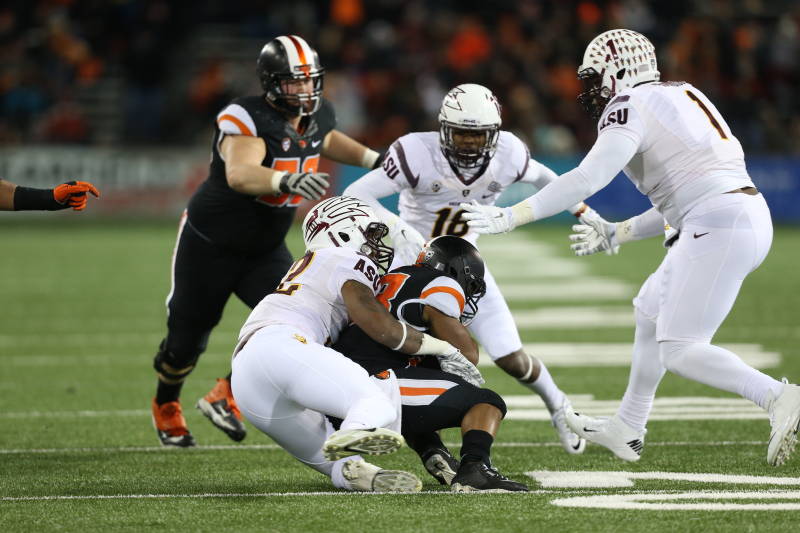
(Photo: ASU Athletics)
It was no secret that Arizona State’s defense would be in full blitz mode Saturday night.
Coming off a resounding victory over Notre Dame that featured Everett Golson throwing four interceptions, coughing up a fumble and notching -11 rushing yards, the Sun Devils were a shoe-in to showcase their heavy-blitz defense against Oregon State once again.
Admittedly, ASU gained substantial momentum at times thanks to heavy blitz packages that gifted Damarious Randall an interception and Antonio Longino a scoop-and-score fumble recovery. The Sun Devils also bolstered their tackle for loss production, with seven on the evening. The fact that the unit blitzed on 23 of Oregon State’s first 27 plays truly tells the story of the game.
But the problem with relying on an all-out, blitz-heavy defensive identity is its inevitable propensity to yield big plays. ASU brought the house from the outside edge, and the Beavers proceeded to gash through the middle with run plays. ASU adjusted and brought the pressure up the middle, and the Oregon State line responded by picking it up and made Sean Mannion look like Peyton Manning.
A 78-yard touchdown run from Storm Woods, a 66-yard touchdown run from Terron Woods and a 67-yard touchdown pass by Sean Mannion were the damage and the ultimate cause for ASU’s 35-27 demise.
Sure, players like Viliami Latu, Laui Moeakiola, Damarious Randall and Jordan Simone took poor angles and missed tackles on multiple occasions that enabled these big plays. But still it was clear that because of ill-timed blitz packages, ASU had a personnel shortage on the second and third levels throughout the night.
While the Sun Devils’ College Football Playoff hopes and national title aspirations were surely shattered, their focus has to be quickly diverted to its next three opponents—Washington State, No. 14 Arizona and possibly No. 2 Oregon. Whether the Sun Devils can make the necessary adjustments will dictate whether or not they repeat as Pac-12 South Champions.
Digging into the offensive mechanisms of these three remaining teams, ASU’s blitz-oriented defense may not be conducive to much success.
In large part, ASU found success at times against Oregon State for one primary reason: its offensive line’s dismal season-long protection of quarterback Sean Mannion. Entering Saturday, Mannion had been sacked a whopping 28 times. While that essence only translate into two sacks for ASU, the front seven was able to generate an intense amount of pressure on Mannion throughout the night.
Washington State (20 sacks allowed), Arizona (20 sacks allowed) and Oregon (23 sacks allowed) only handle the blitz a bit better than Oregon State does, but other intangibles about these teams are going to exploit ASU’s (over)aggressiveness.
If Oregon State’s 108.6 rushing yards per game morphed into 264 against an ASU blitz-defense, then it is safe to assume that the Sun Devils rush defense will have its hands full against Arizona, 191 rushing yards/game, and Oregon, 232.1 rushing yards/game.
Also, with four defensive touchdowns over its past four games, yet a margin of victory of only 8.25 points, perhaps ASU’s offense has become too reliant on its defense bailing it out. Is the possibility of forcing a turnover by blitzing incessantly worth the possibility of yielding a big play? Is the defensive touchdown production sustainable?
Particularly against Arizona and Oregon, the answer to both of those questions is a resounding no. The possibility of forcing a turnover through a six- or seven-man blitz is not worth the possibility of yielding a big play because both teams protect the football extremely well.
Anu Solomon, Arizona’s quarterback, has a 25-to-5 touchdown-to-interception ratio. Marcus Mariota, Oregon’s quarterback, one ups him with a 29-to-2 touchdown-to-interception ratio. Simply put, because Arizona and Oregon are so economical while in possession of the football, ASU may be shooting itself in the foot if they throw the kitchen sink at Solomon and Mariota.
With that being said, the ASU defense has developed a contagious swagger over its past five games, as Adam Stites documents here. And that swagger, in large part, has resulted from its blitz identity.
It cannot go understated how important having swagger and confidence is, especially when the task is rebounding from a devastating loss, a Territorial Cup matchup against rival Arizona, and a speculative Pac-12 Championship matchup against uniform-swaggered Oregon.
So, taking both the importance of identity and opponents’ strengths into consideration, for the Arizona State defense to have success against Arizona and Oregon (and Washington State to a lesser extent), there has to be an intelligent and collected swagger.
The defense cannot lose its ball-hawking, blitz-crazed identity, but it must recognize that blitzing in bunches is not the recipe for success in the remaining games.
Follow Jacob Garcia on Twitter @Jake_M_Garcia or connect with him on LinkedIn.


